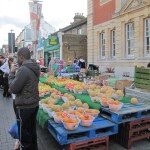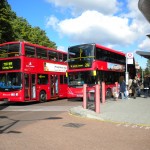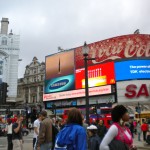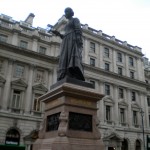Our morning started out great: a nice breakfast, an exciting market to explore, and a seemingly easy route to the Walthamstow market. Upon arriving at the Warren St station, we discovered that the Victoria line, crucial to arrive at Walthamstow market, was closed for engineering. We had been warned that we might want to check to see if all of the lines were working as usual over the weekend… However, we all took that as a “make sure you know where you are going” warning rather than a “look up the closed lines online before you leave” instruction. Oops. Once we figured out how to get to Walthamstow (Central line to Liverpool Street Station to catch the National Rail up to Walthamstow Central), it was a breeze. An hour’s worth of breeze, in fact. Once there, we quickly located the market, which was about a block away from the station.
Our destination, Walthamstow market, had a wonderful selection of fruits, vegetables, clothes, pots and pans, handbags, toys, lace, material, and other random items- all very reasonably priced. People arrived with empty bags with wheels to carry their shopping home. (One lady complained to a friend that she had bought too much and her husband was going to fuss at her.)
It was a very demographically diverse area, we saw people from various countries in Africa, Eastern Europe, the Middle East, and India. In the couple of hours we were there, we heard at least ten different languages. The vendors themselves were predominantly English or from the Middle East. When walking around the community, we noticed a multicultural center, giving us the impression that the community was aware of its diversity and more than likely sought a way to embrace it. Around the market were more specialized stores, which included fabric stores, grocery stores, candy stores, a Pound Power store (everything was a pound; equivalent to the American 99₵ store), and most importantly, a variety of cultural restaurants.
On our way back to the Arran House, we decided to be just a bit more touristy and take a double-decker bus to see more of the area and London itself. Seemingly great idea, but like this morning, it became a hugely complicated decision by a number of factors. Firstly, we weren’t sure what route to take because we were unsure of where in England they would take us. Secondly, when we did decide what route would be the easiest, we were unaware that the bus station we were at contained two other platforms; therefore we assumed the bus that would be the easiest to get back to the house did not stop where we were. After waiting for an alternate bus, only to watch it get full and drive off, we discovered our original bus did stop there- just further up the street! We ended up taking the 48 bus to Liverpool St station, catching the Central Line to Tottenham Court Rd and transferring to the Northern Line to Goodge St. Can you say HOME SWEET HOME?
For more info: http://www.walthamforest.gov.uk/index/environment/walthamstow-market.htm
[kml_flashembed movie="http://www.youtube.com/v/nvHDEVwQrjY" width="425" height="350" wmode="transparent" /]
Video on YouTube
Tags: 2010 Jamie · 2010 MatthewM · 2010 Stephenie
August 26th, 2010 · 1 Comment
Upon leaving the Arran House Hotel, we decided to walk to the Tottenham Court Road Underground Station. This is likely the most efficient way to Notting Hill Gate, as we were able to take the Central Line directly to that station in less than fifteen minutes. The walk down Tottenham Court Road felt much like a normal, bustling, city street. Other than the presence of the Dominion Theatre right next to the Underground stop, nothing about the walk was distinctively “London.” However, once we entered the station we began to see much more of the cultural hodgepodge London society. A highlight was the sight of a couple making out on the train across from two women in burkas. The fact that such alarmingly different cultures could exist in the same car of the same train rang true with much of our summer reading about London.

Once we arrived at Notting Hill Gate, we found an abundance of ethnic restaurants lining the street. While we thought such different eateries would imply a diverse population, we found the exact opposite to be true. The area was filled with almost entirely white, apparently upper-class, by-passers. With a few dramatic exceptions, we found the area to be quite upscale, with immaculately designed townhomes and expensive restaurants and shops.

The station is named Notting Hill Gate because it is located on Notting Hill, which historically was the home to several toll gates. The station is here because of both commercial and residential appeal of Notting Hill Gate. People would travel to Notting Hill Gate because the area is almost a perfect living example of the hodgepodge of London’s cultural identity. The streets have a variety of ethnic restaurants – there’s a tapas bar next to a dim sum restaurant, which is across the street from a kabob restaurant – as well as a selection of oddities and clothing shops. There is no rhyme or reason to this area; Notting Hill Gate is a collection of interests from a variety of different cultures. There is also a residential aspect, which ranges from growing upper middle class town houses to large flat buildings for people living paycheck to pay check. It is in the Royal Borough of Kensington and Chelsea.

At our site we found a giant elephant statue. It was a large metal elephant that was more air than substance – it was made of thin wires that intersected each other in a flowy pattern with a fan where an eye would be. It was located outside of the Newcombe House on Notting Hill Gate. The elephant is one in a series all over London to raise awareness about the upcoming Elephant Parade Event, which raises money for elephants world-wide. The upcoming parade is not new but this is the first year it will be held in London. As far as we saw no one took notice  of the statue.
of the statue.
In an attempt to find out where the Notting Hill Carnival, an upcoming event, would be taking place, we decided to follow some signs that directed us to the point of the future festivities. Unfortunately, the signs quickly disappeared, and were (apparently) replaced with blue arrow signs attached to several poles up and down the street. As we began the trek down the roads where the signs were, we came across even more signs of affluence. There were gourmet shops, fishmarkets, and even a tailor shop packed with sewing machines. This was all quite fascinating, but at this point we had walked about 25 minutes and had not found the site of the carnival (so we thought). So we decided to make our way to the nearest Underground station. After some help from a woman on the street (Who introduced herself via weather-speak), and some more aimless wandering, we finally located the Ladbroke Grove Underground Station. At this point, we were exhausted. Luckily we were able to catch the Hammersmith & City line all the way back to the Euston Square Station, which was only a few blocks from the hotel. This trip took about half an hour, which combined with our forty minute hike through the streets of Notting Hill, was not quite as quick as our other route. Also, the train became packed at the Baker Street exit with mostly businessman making their way home. By the way, the carnival takes place on several of the streets of the Notting Hill area, so we did find it… a couple of times.
More information about the Notting Hill Carnival at: http://www.thenottinghillcarnival.com/
Tags: 2010 Amy · 2010 Andrew
August 26th, 2010 · 1 Comment
To get to St. Paul’s Station, we took the Tube from Goodge Street Station to the Tottenham Court Road Station, and then stayed on the central line for a few more stops until we arrived at St. Paul’s. It took us a little over ten minutes to get from the hotel to Saint Paul’s, including walking down 169 steps after we decided to skip the escalator. The Tube was very easy to navigate, although the map certainly came in handy. Holly, whose town has absolutely no public transportation, was impressed by how orderly everything was—people paid strict adherence to instructions to “mind the gap” and to keep right if they weren’t moving on the escalator, so as to let those in more of a hurry pass by.

St. Paul’s proved to be a very popular station, probably because it offers access to many London landmarks and museums, including St. Paul’s Cathedral, for which it is named. It is also within walking distance of the Tate Modern and St. Bartholomew’s Hospital, as well as several office buildings. Walking around the area around the station, we realized that St. Paul’s is a gateway to the City proper. 
Just beyond the station lies St. Paul’s Cathedral surrounded by beautiful old buildings that resembled a postcard image of London. We decided that the cathedral itself was the best monument to highlight, as it is such an iconic part of the London skyline and is a standing monument to Sir Christopher Wren’s work. 
The area outside of the cathedral was teeming with tourists, most of whom did not display much religious inclination. There were a number of people milling around inside of the cathedral, but very few were actually there to pray or worship, and they were secluded at the front of the church.
There were also several groups of tourists outside of the church, and we were surprised at how informally they treated the area. One tour guide even jumped onto a statue of John Wesley and put his arm around the statue while he talked to the group. In general, people seemed to be more intent on taking pictures than on listening to the tour guide or reading the plaques (of which there were very many) that explained the significance of St. Paul’s. History was emphasized, however, with all of the plaques in the area. There were several statues on the cathedral grounds that commemorated religious figures, including St. Paul’s cross, which was supposedly erected first in 1191. On the other side of the station, we found Christ Church Greyfriars, another Wren creation, which was partially destroyed. The ruins of the knave have since been turned into a garden. This section seemed more business-y than the area immediately around St. Paul’s Cathedral, however.
On the walk back from Saint Paul’s Cathedral, we chose to walk down Newgate Street, which soon turns into High Holborn. Along this stretch, Baroque style architecture, characterized by ornate marble carvings and columns predominated. 
Soon enough, we walked upon the Holborn circus, a tiny traffic circle with a statue in the middle,. Finding the subject of the statue was made difficult by the traffic moving quickly around it, however, we later found the statue to be of Prince Albert. As we moved toward New Oxford Street, the architecture tended to be more of the modernist variety, with the odd Victorian building, and Georgian style architecture becoming more predominant in Bloomsbury.
Tags: 2010 Holly · 2010 Tyler
August 26th, 2010 · 1 Comment
For our Tube exercise, we travelled to Walthamstow. It is relatively far east (think Salaam Brick Lane east).
We started our journey at the Goodge Station and took the Northern Line north to the Warren Street station where we changed lines and rode the Victoria Line all the way east to the Walthamstow Central Station.
On the Tube, as in Watching the English, most people just kept to themselves. A few people were conversing loudly, but this was not the norm. Most people were travelling by themselves and avoided eye contact.
We noticed that the number of people on the line thinned out as the train travelled east. This seemed to be a reflection upon the geographic location of the stop and its relation to the socioeconomic standing of that area of London.
The obvious reason that people would travel to this stop is its proximity to nearby train and bus stations as well as open-air markets and shopping centers.
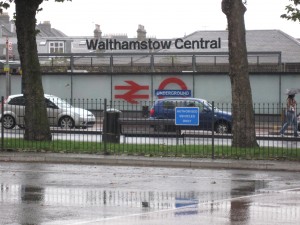
The area surrounding the station seemed to be primarily Afro-Caribbean and Middle Eastern. Many of the shops were targeted towards- and in fact, labelled for- these ethnicities.

Interactions between people on the street and in the mall were very lively and fast-paced. We observed (and heard) a vendor singing to advertise his goods and his patrons joined in. The fruits and banners in the market were brightly colored and visually stimulating, adding to the vibrancy and vividness of the scene.
Although there were no traditional monuments or plaques in the area, we came upon a library that was an interesting blend of modern and 18th – early 19th century design.

The architectural grandeur and elegance of its exterior served as a sort of centerpiece for the neighborhood.
In order to get back to Arran House, we took the Victoria Line from Walthamstow Central Station to the Finsbury Park Station. We then switched to the Picadilly Line and followed it to Holburn Station. From there we braved the rain and made our way (slowly) back to the hotel.
While on the underground on the way home, we had a fairly similar experience to that of the original trip. It was relatively uncrowded- we were able to sit all the way back- and people did not interact. A pair of men who had been talking loudly in the station continued their conversation on the train, much to the annoyance of a young mother sitting near them. She did not chastise them for their behavior but instead quietly looked away and rolled her eyes. This simple interaction seemed to us to be quintessentially British, at least based on Kate Fox’s observations.
Tags: 2010 Jessica · 2010 Patrick
Our adventure through London commenced with a magical trek from Arran House to Euston St. where we crossed the scariest intersection ever, and got onto the Underground at the Warren Street Station. We passed several colleges on the short walk there. Upon entering the Tube, we were nearly stampeded by what we assumed was a mass of English people fleeing Godzilla, but apparently it was just the normal speed people walk on the left side of the playbill decorated escalator (only the right side is for standing). On the approximately 10 minute ride, we noticed a lot of traditional religious dress, including Jewish men wearing yarmulkes and Muslim women wearing head scarves. This manner of dress was replaced in a dramatic way upon our exit from the station onto main street of Camden Town, part of the Borough of Camden in northwest London, by another form of culturally-influenced dress. The downtown area was filled with many aspects of thriving goth and punk sub-cultures. Tattoo parlors advertised themselves with what looked like controversial picket signs, reflecting a style rooted in subversive movements. Punk and alternative clothing outlets (some with plastic mannequin legs covered in ripped tights in place of awnings), independent record sales on corners, and many, many piercings filled every inch of the street (We received 4 piercing pamphlets within 5 minutes of arriving). Dreadlocks and mohawks ruled the day. This was very much in keeping with the spirit of Camden Town, though not in regards to its original namesake, the 1st Earl Camden, but rather by the integral part it played (and continues to play) in the development of the goth, punk, and underground music sub-cultures.
In addition to still being a gathering place for rebellious youth, Camden Town also features a huge variety of ethnic cuisine in fast food or market formats. The Camden Town Market appears to be an eccentric, large, and broad conglomeration of peoples and things from throughout the world. Throughout the Market, there were large bronze statues of lions in a Sphinx-like pose, an image that was repeated in all of the Market’s advertising. These figures’ effect on the population was amusing to behold as tough teens went over to pose with the statues, which represent the area that reflects their anti-conformist natures. Unfortunately, when we were preparing to take a picture of one of the monuments, we were caught in heavy rain which might have damaged the camera, and turned our return trip to the Arran House into a much less pleasant and enjoyable endeavor, as we had arranged our Tube departure to allow us to walk most of the way home, through Bloomsbury via Camden Town to Tottenham Court Road, where we changed direction and took Bloomsbury Street until it became our own Gower Street. On a brighter note, we did get to see some of those awesome Harry Potter-esque double decker buses.
Tags: 2010 Elizabeth · 2010 Jesse · 2010 MatthewM
August 26th, 2010 · 1 Comment
Professor Qualls assigned us Piccadilly Circle. The hardest part was figuring out what Tube station to start from – we didn’t know what was the closest to the Arran Hotel, so that took a little bit of aimless walking around Tottenham Court Road (not that we’ce complaining). It was the Goodge Street station we were after, and we think that being able to find it will be useful before long.
Matt spent the summer in New York City, and Mary Kate has used the New York subway on occasion, and neither of us has ever seen anything quite like the Tube. Its walls are plastered in colorful ceramic tile – untainted by graffiti – and the advertisements lining the walls of the railway promote opera and theater. In speaking of opera, the performers trying to make money in the subway seem to have a different repertoire here: we heard an opera singer and soft-rocker on a keyboard in our stations today. The Goodge Street station also featured a winding staircase of 136 stairs – we were surprised when we expected to run down two flights as a quicker alternative to the lift.
We took Goodge to Tottenham Court Rd, and from there we transferred to the Piccadilly Line at Leicester (pronounced “Lester”?) Square. None of our rides on the Tube were longer than 90 seconds, and every time we found our platform, the Tube train was already waiting for us. (The instant train access was another thing we weren’t used to from American subway systems.) When we climbed out of the Piccadilly Station, named for the Piccadilly Circus, and into the City of Westminster, we felt a world away from Gower Street. “This is the Times Square of London,” Matt immediately remarked. Flashing lightbulbs, MacDonald’s advertisements (and stores), punk rockers with orange spiked hair posing for pictures (for a few quid), and plenty of traffic made us feel more like we were in an American city than we have felt yet. The architecture of the buildings , though– on the second level, above the franchise coffee shops and tourist-y clothing stores – reminded us we were in London: regal brick and stone with ornate facades, often topped with statues or domes lined the streets in all directions. Several tourists asked us to take their pictures in front of statues, and we spotted a few posing outlandishly in front of fountains.
Our favorite memorial statue in Piccadilly Circus was a little further away from the hustle and bustle surrounding the central fountains and monuments. We gravitated toward the Crimean War memorial. (Although it should be noted that actually getting across traffic to reach the memorial is much easier said than done.) It featured a statue of Florence Nightingale, where people continue to leave bouquets of flowers in her honor.
Getting back to the Arran House (even in our fog of jet lag), proved to be a snap. We took a different route – Piccadilly to Oxford Circus to Tottenham Ct. Rd. and a three-block walk home – and got to see a few pubs and store fronts we missed the first time around.
Tags: 2010 MaryKate · 2010 MatthewG
After a short tour of Tottenham Court Road, Paul and Chelsea set off for Barbican from Goodge Street station. Barbican and Goodge Street aren’t located terribly far away from each other, but because of the way the Underground system is laid out, we had to go all the way down to Embankment to meet the Circle Line in order to take it to Barbican, and the Tube journey alone probably took twenty minutes or so in itself.
The Barbican station surprisingly was outdoors, unlike most other stations we had seen. It lets out onto a fairly busy street, and we headed straight across it for Beech Street (which is actually a sort of tunnel), not knowing we were heading away from the Central Markets and the Museum of London. We ended up in a mostly residential area full of “estate houses,” which we thought meant low-income housing, but many of the buildings looked decent and well kept-up for the most part, making us question if that’s really what “estate houses” meant. We came across a small park and an elementary school, as well as an old building marked as a “free library,” which turned out to actually be offices for UBS and not a library at all. This building was a tall red-brick building with elaborate arches and ledges, which was in stark contrast to the concrete block apartment building right across the street. In addition, we found a Welsh church, but couldn’t glean much information besides the fact that it had been established in 1774 due to the fact that the signs were written in Welsh. The majority of the people we saw walking around were white and middle class in appearance, even though it was probably a more lower-income area. However, the area seemed very quiet and there were very few people on the street.
Walking only a block away from the residential area, we came to the Square Mile City and were dwarfed by the massive high-income office buildings. This area was in direct contrast to the estate houses simply on the other side of the street. The farther on we walked, there were more and more modern glass and steel buildings, as well as men in suits and boutique shops. Deciding to head back, we found Moorgate Tube station and took a different route back home, taking the District Line and ending up at Tottenham Court Road and a short walk to the hotel.
We’re having technical difficulties getting the pictures up, but we hope to have that worked out soon.
Tags: Chelsea · Paul

